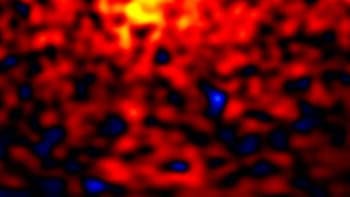Many astronomers believe that the universe is dominated by cold 'dark matter' and 'dark energy' - a view that has been confirmed by recent measurements on the cosmic background radiation. Now, however, a group of astrophysicists in the UK has found that this radiation - the microwave 'echo' of the big bang - may in fact have been modified or ‘corrupted’ as it passed through galaxy clusters on its way to Earth. The result could undermine previous evidence for both dark matter and energy (Monthly Notices of the Royal Astronomical Society 347 L67; arxiv.org/abs/astro-ph/0306180)
The cosmic microwave background provides a picture of the universe as it was some 400 000 years after the big bang. By this time, the universe had cooled down enough for atoms to form, which means that there were no longer any free electrons to scatter the photons produced in the early universe. Any variations or anisotropy in the temperature of the background radiation therefore reflect variations in the density of the universe at this time.
These temperature fluctuations can be expressed as a sum of spherical harmonics, and astrophysicists plot the relative strength of these harmonics as a function of angle. The height and positions of the peaks in this so-called ‘power spectrum’ are related to basic astrophysical properties of the universe.
Data from the first year of NASA’s Wilkinson Microwave Anistropy Probe (WMAP) satellite – unveiled in February 2003 – support the currently popular concordance model of the universe. This model predicts that the universe is a cocktail of 5% ordinary matter, 25% undetectable dark matter and 70% dark energy – the nature of which is unknown.
Now, Tom Shanks and colleagues at Durham University have performed a new analysis of the WMAP data by looking at positions in the sky where galaxy clusters are abundant. They found that the positions of these clusters generally coincided with positions of low temperature in the microwave background data.
According to the team, this could be because the hot gas in the galaxy clusters has scattered the cosmic microwave background radiation and distorted the background spectrum. This so-called Sunyaev-Zeldovich effect can reduce the temperature of the microwave background and WMAP physicists themselves have already reported on observing the effect close to galaxy cluster centres.
Shanks and co-workers now believe that the distortion could extend to scales of 1 degree on the sky – an area much larger than previously detected. This would mean that the first and biggest peak in the power spectrum could be affected. Until now, the Sunyaev-Zeldovich effect had only been observed near much smaller angles. “Since the first peak is the one that seems to support a cold dark matter universe, any problem here could ultimately weaken the evidence for a universe that contains dark matter and dark energy,” Shanks told PhysicsWeb.
The team now plans to search for the effect in more distant galaxy clusters using further data from WMAP and the Planck Surveyor, which is due to be launched later this decade.



